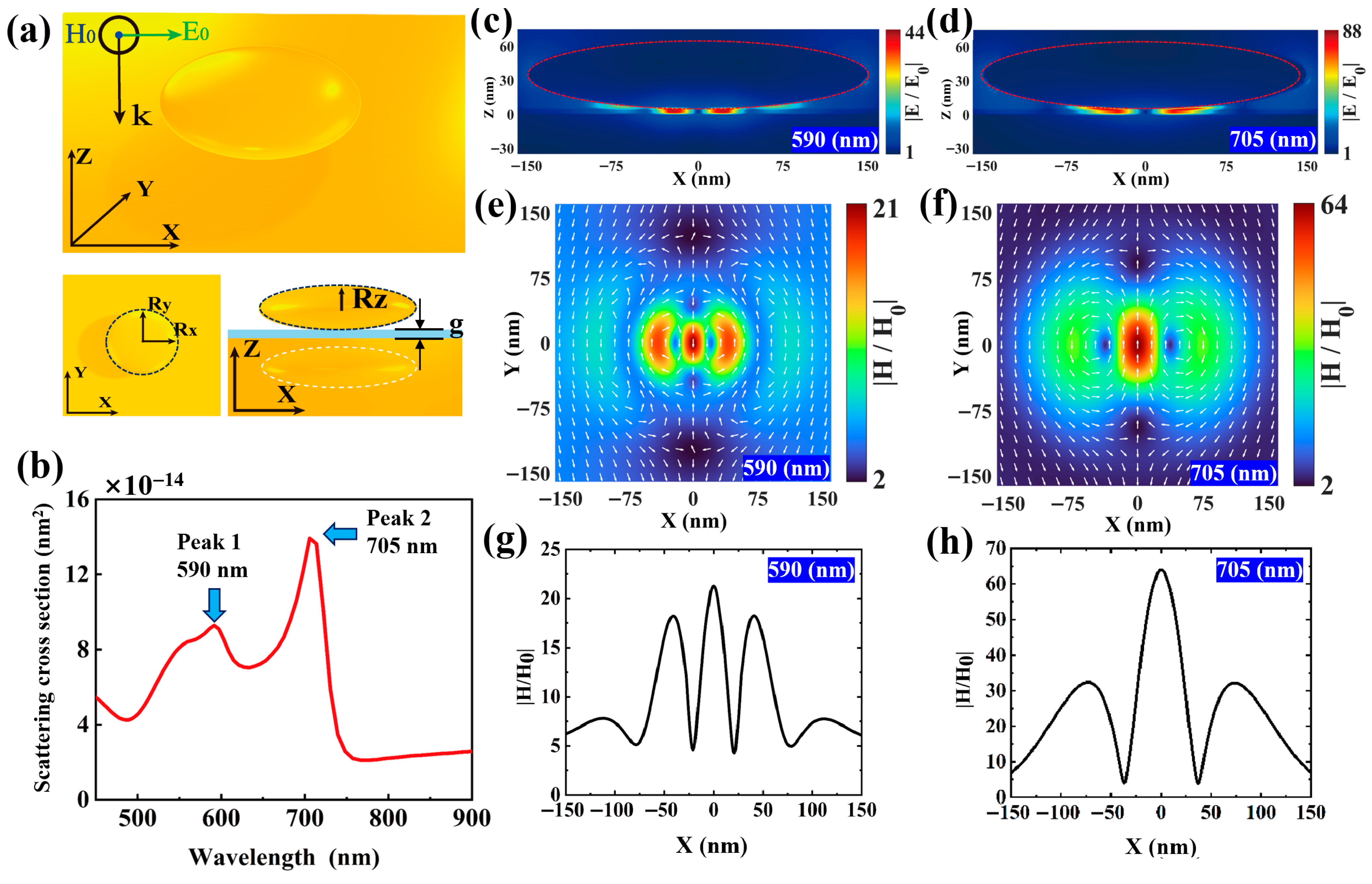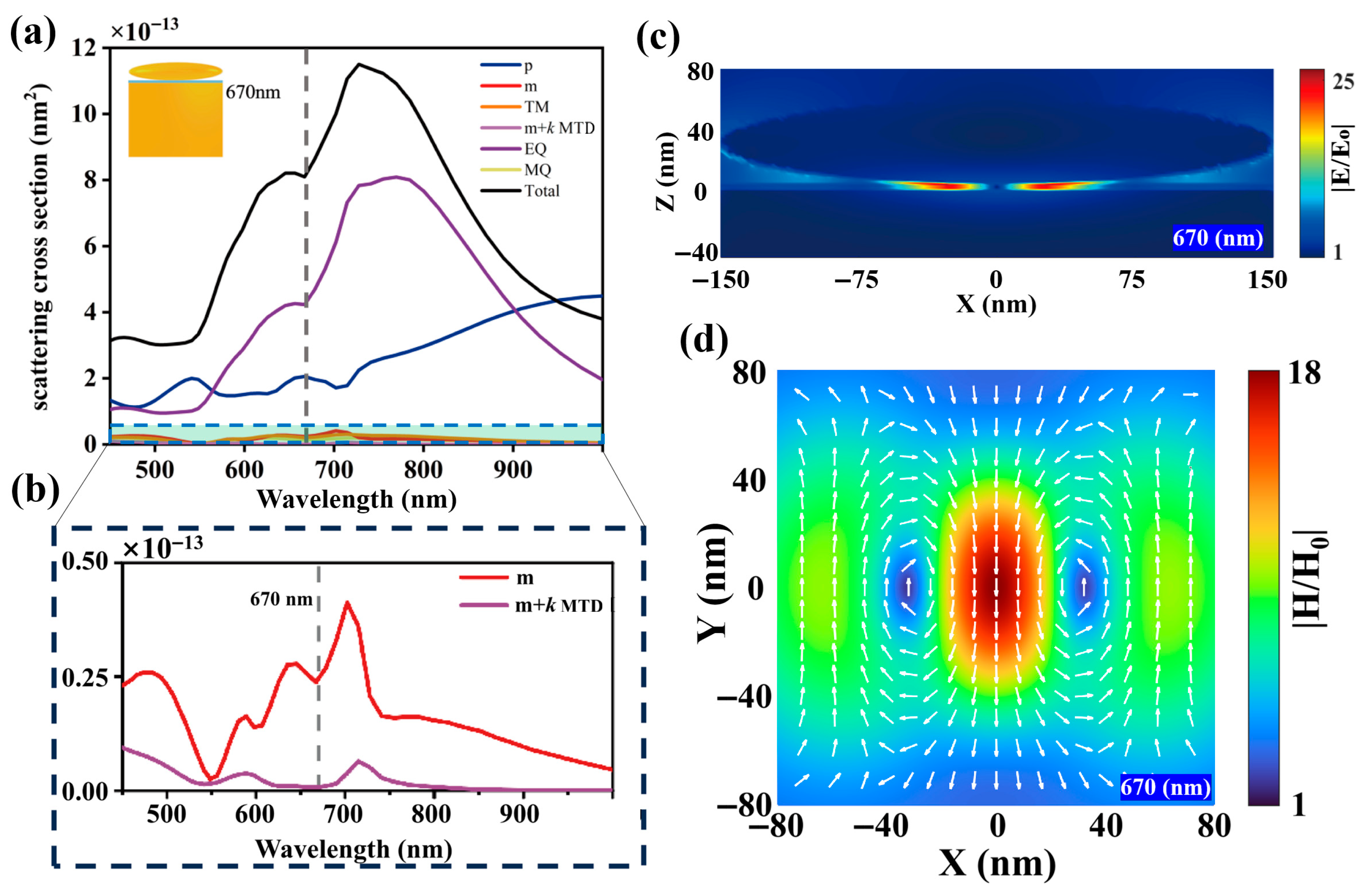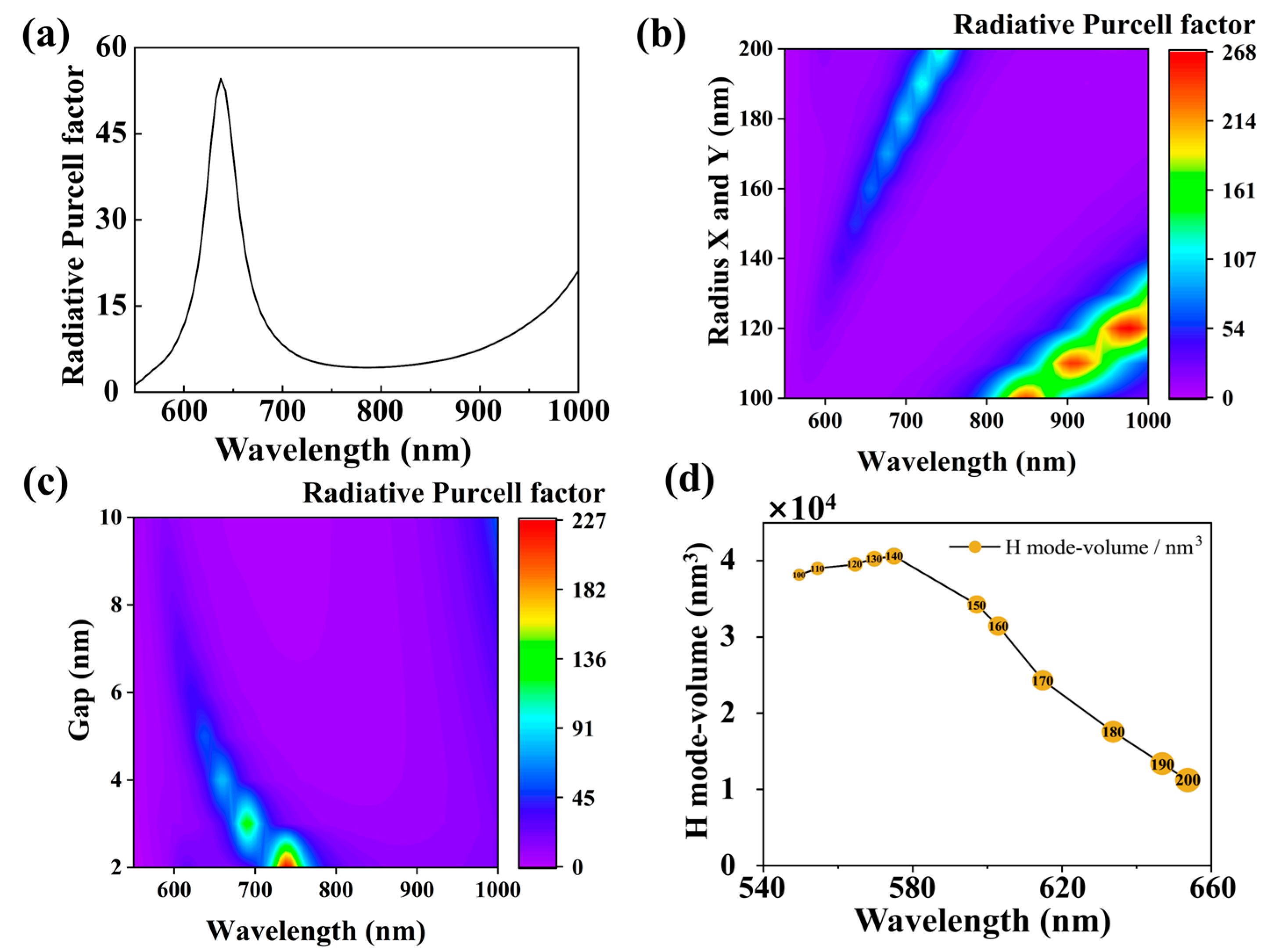Magnetic Purcell Enhancement by Plasmon-Induced Magnetic Anapole Mode in the Gap of Oblate Nano-Ellipsoid on Metal Mirror Structure
Abstract
1. Introduction
2. Results and Discussion
3. Conclusions
Supplementary Materials
Author Contributions
Funding
Data Availability Statement
Conflicts of Interest
References
- Sugimoto, H.; Fujii, M. Magnetic Purcell Enhancement by Magnetic Quadrupole Resonance of Dielectric Nanosphere Antenna. ACS Photonics 2021, 8, 1794–1800. [Google Scholar] [CrossRef]
- Kasperczyk, M.; Person, S.; Ananias, D.; Carlos, L.D.; Novotny, L. Excitation of Magnetic Dipole Transitions at Optical Frequencies. Phys. Rev. Lett. 2015, 114, 16. [Google Scholar] [CrossRef]
- Wu, H.-W.; Li, Y.; Chen, H.-J.; Sheng, Z.-Q.; Jing, H.; Fan, R.-H.; Peng, R.-W. Strong Purcell Effect for Terahertz Magnetic Dipole Emission with Spoof Plasmonic Structure. ACS Appl. Nano Mater. 2019, 2, 1045–1052. [Google Scholar] [CrossRef]
- Hein, S.M.; Giessen, H. Tailoring Magnetic Dipole Emission with Plasmonic Split-Ring Resonators. Phys. Rev. Lett. 2013, 111, 2. [Google Scholar] [CrossRef] [PubMed]
- Hussain, R.; Kruk, S.S.; Bonner, C.E.; Noginov, M.A.; Staude, I.; Kivshar, Y.S.; Noginova, N.; Neshev, D.N. Enhancing Eu3+ Magnetic Dipole Emission by Resonant Plasmonic Nanostructures. Opt. Lett. 2015, 40, 8. [Google Scholar] [CrossRef] [PubMed]
- Shen, S.; Meng, L.; Zhang, Y.; Han, J.; Ma, Z.; Hu, S.; He, Y.; Li, J.; Ren, B.; Shih, T.-M.; et al. Plasmon-Enhanced Second-Harmonic Generation Nanorulers with Ultrahigh Sensitivities. Nano Lett. 2015, 15, 6716–6721. [Google Scholar] [CrossRef]
- Feng, T.; Zhang, W.; Liang, Z.; Xu, Y.; Miroshnichenko, A.E. Isotropic Magn. Purcell Effect. ACS Photonics 2017, 5, 678–683. [Google Scholar] [CrossRef]
- Chen, S.; Zhang, Y.; Shih, T.-M.; Yang, W.; Hu, S.; Hu, X.; Li, J.; Ren, B.; Mao, B.; Yang, Z.; et al. Plasmon-Induced Magnetic Resonance Enhanced Raman Spectroscopy. Nano Lett. 2018, 18, 2209–2216. [Google Scholar] [CrossRef]
- Wang, Y.; You, Q.; Li, Z.; Zhang, L.; Zhang, D.; Wang, P. Strong Coupling of Plasmonic Nanorods with a MoSe2 Monolayer in the Near-Infrared Shortwave Region. J. Phys. Chem. C 2024, 128, 5280–5287. [Google Scholar] [CrossRef]
- Choi, B.; Iwanaga, M.; Sugimoto, Y.; Sakoda, K.; Miyazaki, H.T. Selective Plasmonic Enhancement of Electric-and Magnetic-Dipole Radiations of Er Ions. Nano Lett. 2016, 16, 5191–5196. [Google Scholar] [CrossRef]
- Li, G.-C.; Xiang, J.; Zhang, Y.-L.; Deng, F.; Panmai, M.; Zhuang, W.; Lan, S.; Lei, D. Mapping the Magnetic Field Intensity of Light with the Nonlinear Optical Emission of a Silicon Nanoparticle. Nano Lett. 2021, 21, 2453–2460. [Google Scholar] [CrossRef]
- Vaskin, A.; Mashhadi, S.; Steinert, M.; Chong, K.E.; Keene, D.; Nanz, S.; Abass, A.; Rusak, E.; Choi, D.-Y.; Fernandez-Corbaton, I.; et al. Manipulation of Magnetic Dipole Emission from Eu3+ with Mie-Resonant Dielectric Metasurfaces. Nano Lett. 2019, 19, 1015–1022. [Google Scholar] [CrossRef]
- Kuznetsov, A.I.; Miroshnichenko, A.E.; Brongersma, M.L.; Kivshar, Y.S.; Luk’yanchuk, B. Optically Resonant Dielectric Nanostructures. Science 2016, 354, 6314. [Google Scholar] [CrossRef]
- Meng, Y.; Zhang, Q.; Lei, D.; Li, Y.; Li, S.; Liu, Z.; Xie, W.; Leung, C.W. Plasmon-Induced Optical Magnetism in an Ultrathin Metal Nanosphere-Based Dimer-on-Film Nanocavity. Laser Photonics Rev. 2020, 14, 9. [Google Scholar] [CrossRef]
- Luk’yanchuk, B.; Zheludev, N.I.; Maier, S.A.; Halas, N.J.; Nordlander, P.; Giessen, H.; Chong, C.T. The Fano Resonance in Plasmonic Nanostructures and Metamaterials. Nat. Mater. 2010, 9, 707–715. [Google Scholar] [CrossRef]
- Fan, J.A.; Bao, K.; Wu, C.; Bao, J.; Bardhan, R.; Halas, N.J.; Manoharan, V.N.; Shvets, G.; Nordlander, P.; Capasso, F. Fano-like Interference in Self-Assembled Plasmonic Quadrumer Clusters. Nano Lett. 2010, 10, 4680–4685. [Google Scholar] [CrossRef]
- Roller, E.-M.; Khorashad, L.K.; Fedoruk, M.; Schreiber, R.; Govorov, A.O.; Liedl, T. DNA-Assembled Nanoparticle Rings Exhibit Electric and Magnetic Resonances at Visible Frequencies. Nano Lett. 2015, 15, 1368–1373. [Google Scholar] [CrossRef]
- Zhang, F.L.; Yi, J.; Peng, W.; Radjenovic, P.M.; Zhang, H.; Tian, Z.Q.; Li, J.F. Elucidating Molecule–Plasmon Interactions in Nanocavities with 2 nm Spatial Resolution and at the Single-Molecule Level. Angew. Chem. Int. Ed. 2019, 58, 12133–12137. [Google Scholar] [CrossRef] [PubMed]
- Zhang, F.-L.; Yi, J.; Lin, W.; You, E.-M.; Lin, J.-S.; Jin, H.; Cai, W.; Tian, Z.-Q.; Li, J.-F. Gap-mode Plasmons at 2 nm Spatial-resolution under a Graphene-mediated Hot Spot. Nano Today 2022, 44, 101464. [Google Scholar] [CrossRef]
- Li, Z.; Li, Y.; You, Q.; Wang, M.; Zhu, C.; Yang, Y.; Luan, H.; Wang, P. Magnetic Purcell Enhancement by Plasmon-induced Magnetic Resonance of the Nanoparticle-on-mirror Configuration. Phys. Rev. A 2024, 110, 013516. [Google Scholar] [CrossRef]
- Ren, Y.; Li, Y.; Xu, Z.; Li, X.-F.; Li, J.; Gu, S.; Wang, P.; Wang, M.; Li, Z. Magnetic Radiative Purcell Enhancement by Magnetic Anapole in the Gap of Nanodisk on Metal Mirror Structure. Opt. Express 2025, 33, 14. [Google Scholar] [CrossRef] [PubMed]
- Russell, K.J.; Yeung, K.Y.M.; Hu, E. Measuring the Mode Volume of Plasmonic Nanocavities Using Coupled Optical Emitters. Phys. Rev. B 2012, 85, 24. [Google Scholar] [CrossRef]
- Lo, T.W.; Chen, X.; Zhang, Z.; Zhang, Q.; Leung, C.W.; Zayats, A.V.; Lei, D. Plasmonic Nanocavity Induced Coupling and Boost of Dark Excitons in Monolayer WSe2 at Room Temperature. Nano Lett. 2022, 22, 1915–1921. [Google Scholar] [CrossRef]
- He, Z.; Li, F.; Zuo, P.; Xu, C.; He, W.; He, J.; Zhou, Y.; Zhang, Q.; Chen, K.; Huang, H.; et al. Strong Coupling in a Hybrid System of Silver Nanoparticles and J-Aggregates at Room Temperature. J. Phys. Chem. C 2022, 126, 17141–17151. [Google Scholar] [CrossRef]
- Chen, S.; Meng, L.-Y.; Shan, H.-Y.; Li, J.-F.; Qian, L.; Williams, C.T.; Yang, Z.-L.; Tian, Z.-Q. How To Light Special Hot Spots in Multiparticle–Film Configurations. ACS Nano 2015, 10, 581–587. [Google Scholar] [CrossRef] [PubMed]
- Akselrod, G.M.; Argyropoulos, C.; Hoang, T.B.; Ciracì, C.; Fang, C.; Huang, J.; Smith, D.R.; Mikkelsen, M.H. Probing the Mechanisms of Large Purcell Enhancement in Plasmonic Nanoantennas. Nat. Photonics 2014, 8, 835–840. [Google Scholar] [CrossRef]
- Zaman, M.A.; Hesselink, L. Plasmonic Response of Nano-C-apertures: Polarization Dependent Field Enhancement and Circuit Model. Plasmonics 2022, 18, 155–164. [Google Scholar] [CrossRef]
- Carlson, C.; Hughes, S. Dissipative Modes, Purcell Factors, and Directional Beta Factors in Gold Bowtie Nanoantenna Structures. Phys. Rev. B 2020, 102, 155301. [Google Scholar] [CrossRef]
- Wang, K.; Crozier, K.B. Plasmonic Trapping with a Gold Nanopillar. Chemphyschem 2012, 13, 2639–2648. [Google Scholar] [CrossRef]
- Ernandes, C.; Lin, H.-J.; Mortier, M.; Gredin, P.; Mivelle, M.; Aigouy, L. Exploring the Magnetic and Electric Side of Light through Plasmonic Nanocavities. Nano Lett. 2018, 18, 5098–5103. [Google Scholar] [CrossRef]
- Murai, S.; Saito, M.; Sakamoto, H.; Yamamoto, M.; Kamakura, R.; Nakanishi, T.; Fujita, K.; Verschuuren, M.A.; Hasegawa, Y.; Tanaka, K. Directional Outcoupling of Photoluminescence from Eu(III)-complex Thin Films by Plasmonic Array. APL Photonics 2017, 2, 026104. [Google Scholar] [CrossRef]
- Yezekyan, T.; Zenin, V.A.; Beermann, J.; Bozhevolnyi, S.I. Anapole States in Gap-Surface Plasmon Resonators. Nano Lett. 2022, 22, 6098–6104. [Google Scholar] [CrossRef]
- Wang, J.; Yang, W.; He, Y. Plasmon-induced Magnetic Anapole Mode Assisted Strong Field Enhancement. J. Chem. Phys. 2023, 159, 24. [Google Scholar] [CrossRef]
- Johnson, P.B.; Christy, R.W. Optical Constants of the Noble Metals. Phys. Rev. B 1972, 6, 4370–4379. [Google Scholar] [CrossRef]
- Miroshnichenko, A.E.; Evlyukhin, A.B.; Yu, Y.F.; Bakker, R.M.; Chipouline, A.; Kuznetsov, A.I.; Luk’yanchuk, B.; Chichkov, B.N.; Kivshar, Y.S. Nonradiating Anapole Modes in Dielectric Nanoparticles. Nat. Commun. 2015, 6, 8069. [Google Scholar] [CrossRef] [PubMed]
- Purcell, E.M. Spontaneous Emission Probabilities at Radio Frequencies. Phys. Rev. 1946, 69, 681. [Google Scholar] [CrossRef]
- Länk, N.O.; Käll, M.; Antosiewicz, T.J. Electromagnetic Energy Distribution in Resonant Quasi Porous Silicon Nanostructures. ACS Photonics 2019, 6, 1706–1714. [Google Scholar] [CrossRef]




Disclaimer/Publisher’s Note: The statements, opinions and data contained in all publications are solely those of the individual author(s) and contributor(s) and not of MDPI and/or the editor(s). MDPI and/or the editor(s) disclaim responsibility for any injury to people or property resulting from any ideas, methods, instructions or products referred to in the content. |
© 2025 by the authors. Licensee MDPI, Basel, Switzerland. This article is an open access article distributed under the terms and conditions of the Creative Commons Attribution (CC BY) license (https://creativecommons.org/licenses/by/4.0/).
Share and Cite
Li, Y.; Li, J.; Xu, Z.; Li, X.; Gu, S.; Li, Z.; Wang, M. Magnetic Purcell Enhancement by Plasmon-Induced Magnetic Anapole Mode in the Gap of Oblate Nano-Ellipsoid on Metal Mirror Structure. Nanomaterials 2025, 15, 1451. https://doi.org/10.3390/nano15181451
Li Y, Li J, Xu Z, Li X, Gu S, Li Z, Wang M. Magnetic Purcell Enhancement by Plasmon-Induced Magnetic Anapole Mode in the Gap of Oblate Nano-Ellipsoid on Metal Mirror Structure. Nanomaterials. 2025; 15(18):1451. https://doi.org/10.3390/nano15181451
Chicago/Turabian StyleLi, Yafei, Jiani Li, Zhuangzhuang Xu, Xiufei Li, Songda Gu, Ze Li, and Meng Wang. 2025. "Magnetic Purcell Enhancement by Plasmon-Induced Magnetic Anapole Mode in the Gap of Oblate Nano-Ellipsoid on Metal Mirror Structure" Nanomaterials 15, no. 18: 1451. https://doi.org/10.3390/nano15181451
APA StyleLi, Y., Li, J., Xu, Z., Li, X., Gu, S., Li, Z., & Wang, M. (2025). Magnetic Purcell Enhancement by Plasmon-Induced Magnetic Anapole Mode in the Gap of Oblate Nano-Ellipsoid on Metal Mirror Structure. Nanomaterials, 15(18), 1451. https://doi.org/10.3390/nano15181451






